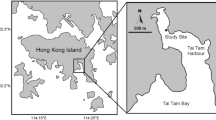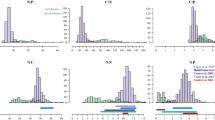Abstract
Abundance–body size relationships are widely observed macroecological patterns in complete food webs and in taxonomically or functionally defined subsets of those webs. Observed abundance–body size relationships have frequently been compared with predictions based on the energetic equivalence hypothesis and, more recently, with predictions based on energy availability to different body size classes. Here, we consider the ways in which working with taxonomically or functionally defined subsets of food webs affected the relationship between the predicted and observed scaling of biomass and body mass in sediment dwelling benthic invertebrate communities at three sites in the North Sea. At each site, the energy available to body size classes in the “whole” community (community defined as all animals of 0.03125–32.0 g shell-free wet weight) and in three subsets was predicted from estimates of trophic level based on nitrogen stable isotope analysis. The observed and predicted scalings of biomass and body size were not significantly different for the whole community, and reflected an increase in energy availability with body size. However, the results for subsets showed that energy availability could increase or decrease with body size, and that individuals in the subsets were likely to be competing with individuals outside the subsets for energy. We conclude that the study of abundance–body mass relationships in functionally or taxonomically defined subsets of food webs is unlikely to provide an adequate test of the energetic equivalence hypothesis or other relationships between energy availability and scaling. To consistently and reliably interpret the results of these tests, it is necessary to know about energy availability as a function of body size both within and outside the subset considered.



Similar content being viewed by others
References
Belgrano A, Allen AP, Enquist BJ, Gillooly JF (2002) Allometric scaling of maximum population density: a common rule for marine phytoplankton and terrestrial plants. Ecol Lett 5:611–613
Belgrano A, Scharler UM, Dunne J, Ulanowicz RE (2005) Aquatic food webs: an ecosystem approach. Oxford University Press, Oxford
Beukema JJ (1987) Influence of the predatory polychaete Nephtys hombergii on the abundance of other polychaetes. Mar Ecol Prog Ser 40:95–101
Blackburn TK, Gaston KJ (1997) A critical assessment of the form of the inter-specific relationship between abundance and body size in animals. J Anim Ecol 66:233–249
Boudreau PR, Dickie LM (1992) Biomass spectra of aquatic ecosystems in relation to fisheries yield. Can J Fish Aquat Sci 49:1528–1538
Brown JH, Gillooly JF (2003) Ecological food webs: high-quality data facilitate theoretical unification. Proc Natl Acad Sci USA 100:1467–1468
Brown JH, West GB (eds) (2000) Scaling in biology. Oxford University Press, Oxford
Cohen JE, Carpenter SR (2005) Species’ average body mass and numerical abundance in a community food web: statistical questions in estimating the relationship. In: de Ruiter P, Wolters V, Moore JC (eds) Dynamic food webs: multispecies assemblages, ecosystem development, and environmental change. Elsevier, Amsterdam, pp 137–156
Damuth J (1981) Population density and body size in mammals. Nature 290:699–700
Dinmore TA, Jennings S (2004) Predicting abundance–body mass relationships in benthic infaunal communities. Mar Ecol Prog Ser 276:289–292
Duplisea DE (2000) Benthic organism biomass size-spectra in the Baltic Sea in relation to the sedimentary environment. Limnol Oceanogr 45:558–568
Duplisea DE, Jennings S, Warr KJ, Dinmore T (2002) A size-based model of the impacts of bottom trawling on benthic community structure. Can J Fish Aquat Sci 59:1785–1795
Gaston KJ, Blackburn TM (2000) Pattern and process in macroecology. Blackwell, Oxford
Greenstreet SPR, Bryant AD, Broekuizen N, Hall SJ, Heath MR (1997) Seasonal variation in the consumption of food by fish in the North Sea and implications for food web dynamics. ICES J Mar Sci 54:243–266
Jennings S, Mackinson S (2003) Abundance–body mass relationships in size-structured food webs. Ecol Lett 6:971–974
Jennings S, Warr KJ, Mackinson S (2002) Use of size-based production and stable isotope analysis to predict trophic transfer efficiencies and predator–prey body mass ratios in food webs. Mar Ecol Prog Ser 240:11–20
Li WKW (2002) Macroecological patterns of phytoplankton in the northwestern North Atlantic Ocean. Nature 419:154–157
van der Meer J (2006) Metabolic theories in ecology. Trends Ecol Evol 21:136–140
Minagawa M, Wada E (1984) Stepwise enrichment of 15N along food chains: further evidence and the relation between 15N and animal age. Geochim Cosmochim Acta 48:1135–1140
Post DM (2002) Using stable isotopes to estimate trophic position: models, methods and assumptions. Ecology 83:703–718
Preston T (1992) The measurement of stable isotope natural abundance variations. Plant Cell Environ 15:1091–1097
Preston T, Owens NJP (1983) Interfacing an automatic elemental analyser with an isotope ratio mass spectrometer: the potential for fully automated total nitrogen and nitrogen-15 analysis. Analyst 108:971–977
Schubert A, Reise K (1986) Predatory effects of Nephtys hombergii on other polychaetes in tidal sediments. Mar Ecol Prog Ser 34:117–124
Schwinghamer P (1988) Influence of pollution along a natural gradient and in a mesocosm experiment on biomass size-spectra of benthic communities. Mar Ecol Prog Ser 46:199–206
Ware DM (2000) Aquatic ecosystems: properties and models. In: Harrison PJ, Parsons TR (eds) Fisheries oceanography: an integrative approach to fisheries ecology and management. Blackwell, Oxford, pp 161–194
Acknowledgments
We thank Carolyn Barnes, Dave Bromley, Dave Carlin, Nick Dulvy, Chris Firmin, Brian Harley, Jan Hiddink, Chris Leakey, Craig Mills, Michaela Schratzberger, Karema Warr, and the officers and crew of CEFAS Endeavour for their efforts in the field, David Maxwell for statistical advice, Stephanie Cogan for freeze-drying all the samples, C. Limpenny and J. Pipe for sediment analysis, and PDZ Europa and Charles Belanger of Iso-Analytical Limited for conducting the stable isotope analyses. Julia Blanchard and two referees provided helpful comments on the text. The research was funded by UK Department of Environment, Food and Rural Affairs contract MF0731.
Author information
Authors and Affiliations
Corresponding author
Additional information
Communicated by Stefan Scheu
An erratum to this article is available at http://dx.doi.org/10.1007/s00442-006-0624-8.
Rights and permissions
About this article
Cite this article
Maxwell, T.A.D., Jennings, S. Predicting abundance–body size relationships in functional and taxonomic subsets of food webs. Oecologia 150, 282–290 (2006). https://doi.org/10.1007/s00442-006-0520-2
Received:
Accepted:
Published:
Issue Date:
DOI: https://doi.org/10.1007/s00442-006-0520-2




